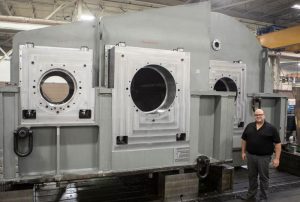Large Scale CNC Machining: How to Approach?
Large scale CNC machining presents both opportunities and challenges for manufacturers. Understanding how to approach it effectively is crucial for achieving optimal results in precision manufacturing projects.

Initial Considerations
Before delving into large scale CNC machining, several key considerations must be addressed:
Size and Capacity Requirements
Assessing the size and capacity requirements of the machining project is paramount. Determine the maximum dimensions and weight of the components to be produced, ensuring compatibility with the capabilities of the CNC machining center.
Material Selection
Selecting the appropriate material is critical for the success of large scale CNC machining projects. Consider factors such as material strength, machinability, and environmental conditions to ensure optimal performance and longevity of the finished components.
Budget and Cost Analysis
Conduct a thorough budget and cost analysis to determine the financial feasibility of the project. Account for expenses such as equipment acquisition, material procurement, labor costs, and overhead expenses to establish a realistic budgetary framework.
Power and Efficiency Optimization
Large scale CNC machining requires robust power and efficiency optimization strategies to enhance productivity and minimize production costs:
High-Power Machining Centers
Invest in high-power machining centers equipped with advanced spindle motors capable of delivering ample torque and cutting force. Optimal spindle power, typically exceeding 50 horsepower, ensures efficient material removal and superior machining performance.
Efficient Tooling Solutions
Utilize high-performance cutting tools specifically designed for large scale CNC machining applications. Carbide inserts, indexable tooling systems, and custom tool geometries optimize cutting performance, prolong tool life, and reduce tooling costs.
Strategic Machining Parameters
Fine-tune machining parameters such as cutting speeds, feed rates, and depths of cut to maximize material removal rates while maintaining dimensional accuracy and surface finish quality. Implementing adaptive machining strategies and dynamic toolpath optimization techniques further enhance efficiency and productivity.
Quality Assurance Measures
Maintaining stringent quality assurance measures is essential to ensure the integrity and reliability of large scale CNC machining processes:
In-Process Inspection
Implement real-time in-process inspection techniques, such as probe systems and laser measurement systems, to monitor dimensional accuracy and detect any deviations from the specified tolerances. Continuous feedback loops enable immediate adjustments and corrective actions, minimizing scrap and rework.
Comprehensive Testing Protocols
Conduct comprehensive testing protocols, including dimensional inspections, material analysis, and functional testing, to validate the performance and reliability of the finished components. Adherence to industry standards and customer specifications ensures compliance and customer satisfaction.
Lifecycle Management and Maintenance
Effective lifecycle management and proactive maintenance practices are imperative for optimizing the longevity and performance of large scale CNC machining equipment:
Preventative Maintenance Scheduling
Develop a proactive preventative maintenance schedule encompassing routine tasks such as spindle lubrication, tool calibration, machine alignment, and coolant system maintenance. Regular inspections and servicing minimize downtime, prevent unexpected failures, and prolong machine lifespan.
Lifecycle Cost Analysis
Perform a comprehensive lifecycle cost analysis to evaluate the total cost of ownership of CNC machining equipment over its operational lifespan. Consider factors such as initial acquisition costs, maintenance expenses, energy consumption, depreciation, and resale value to make informed investment decisions.
In conclusion, approaching large scale CNC machining requires careful planning, strategic optimization, and meticulous attention to detail. By addressing key considerations, optimizing power and efficiency, implementing rigorous quality assurance measures, and adopting proactive maintenance practices, manufacturers can maximize productivity, ensure quality, and achieve success in precision manufacturing projects.
